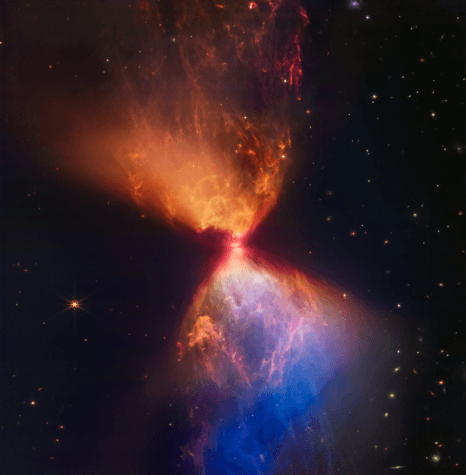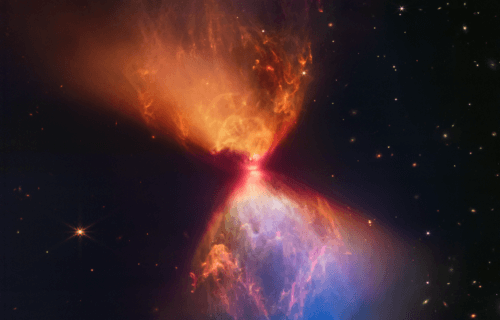GREENBELT, Md. — A new star is born, and it already has an amazing figure! NASA scientists have released a stunning new image that looks like an hourglass on fire. In actuality, it’s a fiery protostar that emerged from the dark cloud L1527, photographed by the James Webb Space Telescope. Tracking the formation of stars could give astronomers more insight into how our own Sun and solar system may have looked in their early stages.
While the star itself is hidden from view in the “neck” of the hourglass shape, a glimpse of it can be seen as a dark line across the middle of the neck. Light from the star is leaking out, creating an illumination within nearby gas and dust. James Webb was successfully able to capture this normally elusive view through its Near-Infrared Camera. The clouds in the Taurus star-forming region can only be viewed in infrared light.
The orange-blue colors seen in the image hold cavities that formed as material shoots away from the protostar and collide with surrounding matter. The colors were the result of accumulating layers of dust between the clouds and the telescope. The thinnest layers of dust exhibit a blue hue. As dust thickens, there is less blue light to escape, creating pockets of orange instead.
As the star moves materials away from it, it shocked filaments of molecular hydrogen. Having shocks and turbulence delays the creation of new stars, which would form all throughout the cloud. With star formation inhibited, the newborn star can take as much space and materials for itself as it wants.

This is a very young star
While it might feel old for humans, 100,000 years is relatively young for a star. Its age, along with the brightness it exudes in far-infrared light makes it a class 0 protostar – the earliest stage for a star. This means that L1527 has a long way to go before it becomes a fully developed star.
For example, L1527 is still within a thick cloud of dust and gas and does not create its own energy through nuclear fusion of energy. Developing energy is an essential component of becoming a fully-fledged star. What’s more, the star is very unstable. The star is in the form of a small, hot, and puffy clump of gas between 20 and 40 percent of the mass of our solar system’s star.
While the new star can’t make its own energy, it is getting closer to doing so as it collects mass. With more mass, the core gradually compresses to a place where it might be able to undergo nuclear fusion. This is seen in the photo where the surrounding dust and gas clouds gravitate towards the center where the star is located.
As material falls in, it creates a dense spiral disk around the center known as an accretion disk. The accretion disk feeds material to the baby star to help it grow bigger. Eventually, all the accumulated mass and compression will trigger a rise in core temperature that would reach the threshold for nuclear fusion.
The disk in the photo may seem small at first glance, but scientists estimate it to be the size of our solar system. NASA astronomers suggest that it’s not unusual for material to clump together in this dense band. The clumping signals the formation of new planets in the distant future.


I find the photo at odds with the description of the engineering drawings of the Webb telescope. In the photo provided, in the lower middle left is a star that has a telltale signature as to how the photo was made. It shows a star with six bursts. The problem with that is the secondary reflecting mirror of the telescope only has the three arms holding it in place according to the drawings. A fingerprint if you will as to what the stars will look like in images produced from the data. For an example look at the Hubble images of the stars and you will see four bursts on all the stars unless the image has been altered or faked. It has four arms holding its secondary mirror. It’s a simple way to tell a fake image when you look at the construction of the telescope compared to the images produced. Someone wasn’t doing the job closely enough in my opinion
Since you are clearly accusing them of faking these images I would like to know, what is the purpose of faking these images, what is gained from it?
Frederick Lange, I answered you in the post dated the 16th. There is serious malfeasance in my accusations because it would amounts to fraud. If it is just an artist rendition then own up to it.
Like anyone foolish enough to be scammed and taken from what they earned, it’s money and a narrative cast upon those who are gullible enough to be ignorant and believe a lie. When a company goes to the trouble of showing you the blueprints of the telescope, you would assume they would at the very least use their technical wizardry to produce CGI’s that match the engineering constraints that cost billions to create and “launch”. So, was this another government funded idea to justify five hundred dollar hammers for the Pentagon or just a small part of the trillions missing or unaccounted for in the Black hole that is our government budgets?
Here is the explanation that I found after a quick google search
https://www.sciencefocus.com/space/diffraction-spikes-jwst/
I know Im a little late to this party but you asked what the purpose of faking the images. Well why did they fake the moon landings? Why do they consently fake being in the ISS with the likes of all the women’s hair unnaturally standing on end and playing with their toys in augmented reality? Why do they fake space walks where bubbles float up past the camera or like that one time Luca Parmitano almost drown in space leading to nasa putting snorkels in the space suit. I don’t know why NASA fakes everything other than helping the cause of making so that everything the American people believe is bullshit. But I do know what is to be gained by faking it. ,” The James Webb Space Telescope (JWST) is expected to cost NASA $9.7 billion over 24 years. Of that amount, $8.8 billion was spent on spacecraft development between 2003 and 2021; $861 million is planned to support five years of operations. Adjusted for inflation to 2020 dollars, the lifetime cost to NASA will be approximately $10.8 billion.” Follow the money! Before you say ” that’s not even1% of the federal budget” if they could have made the price tag a trillion they would have but regardless at best they spent almost 11 billion on the most expensive paint by numbers ever. At worst it’s business as usual in the Empire of Lies.